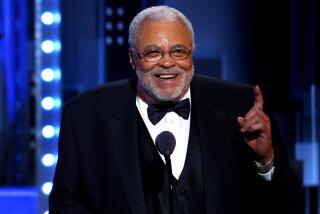‘James Edwards: African American Hollywood Icon’ by Pamala S. Deane
- Share via
For much of the 1950s and ‘60s, Sidney Poitier was the standard-bearer for all of black Hollywood, his stardom held aloft as a beacon of integration and progress. In reality, the movie industry remained largely segregated and out of step with the developments of the civil rights era; the Poitier mythology not only obscured this truth, but it also dwarfed the contributions of other African American actors, some of whom paved the way for Poitier’s ascent.
No one deserves more credit for presaging the stereotype-breaking characters that Poitier perfected than James Edwards, who, in 1949, shot from anonymity to stardom in producer Stanley Kramer’s controversial, race-infused war melodrama, “Home of the Brave.” Gifted, outspoken and unwilling to accept the demeaning caricatures that blacks often played on-screen, Edwards was heralded as the first African American actor to topline a major studio feature in a straight dramatic role.
Since Edwards’ early death in 1970, his iconic stature in African American cinema history has rarely been recognized. In “James Edwards: African American Hollywood Icon,” author Pamala S. Deane admirably tries to remedy this oversight with a compelling-if-workmanlike account of a groundbreaking life and career that were at times starry, other times star-crossed.
Born in 1918 in Indiana, Edwards took up acting after serving in World War II, at a time when many playwrights tackled race relations and discrimination in their works. During his acclaimed stint playing a black ex-G.I. battling Jim Crow racism in one such play, “Deep Are the Roots,” Edwards was hired to star in Kramer’s low-budget war film, which was being developed in secrecy for fear its subject matter would ignite race riots.
In “Home of the Brave,” Edwards portrayed Pvt. Peter Moss, the lone African American in a dangerous reconnaissance mission on a Japanese-held island. When a white soldier calls Moss the N word, Moss suffers an emotional breakdown and is cured by an empathetic white Army psychiatrist. The film’s treatment of racism was considered bold; it was a hit, and Edwards toured the country as a celebrity and an ambassador between races. Edwards was “showered with awards, honored with his own parade, and given the keys to the city of Harlem,” Deane writes.
But his stardom was short-lived, and in the 1950s and ‘60s, Edwards settled for a career as a sturdy, recognizable character actor. Except for a few prominent parts -- in Sam Fuller’s 1951 Korean War drama “The Steel Helmet,” the 1962 Cold War thriller “The Manchurian Candidate” and 1970’s “Patton” -- Edwards had mostly undistinguished, second-tier film and television roles.
His situation was no different from that of other black actors trying to survive. In the two decades following Edwards’ breakthrough in “Home of the Brave,” the roles improved, but the percentage of African American employment in Hollywood didn’t increase much, if at all.
Deane refuses to lay blame on institutional racism. The movie industry, she points out, was undergoing tremendous economic struggles in those years, and many once-prominent white actors were struggling as well. But the towering shadow of Poitier is discussed only briefly, and it becomes something of an elephant in the room. After his debut as a doctor in 1950’s “No Way Out” -- Edwards was passed over for the role -- Poitier quickly supplanted Edwards as the black actor most associated with the liberal-minded “problem pictures” of the era.
Edwards’ career may also have been hamstrung by his views. Emboldened by success, he spoke out against demeaning roles and criticized “Amos ‘n’ Andy” in particular. And when FBI agents pressured Edwards to testify before the House Un-American Activities Committee and disavow leftist actor Paul Robeson, Edwards refused. Deane hints that Edwards’ political ties might have been a liability, but because his FBI file has been destroyed, she cannot verify this.
Edwards endured personal struggles, including failed financial ventures, extramarital affairs, charges of violence against women and rumors of heavy drinking. Though all these factors may have contributed to his fallen stardom, the real tragedy lay in the way the mainstream press largely forgot Edwards’ contributions after he wore out his usefulness as a symbol.
The African American public and press didn’t forget, however, and considered Edwards a star even if he never had another starring role. “To black citizens of the period, who often made a point of attending any film that included a black character, Edwards’ presence,” Deane writes, “was far from routine, but at times an event.”
Ryfle is writing a book about Hollywood during the civil rights era.
More to Read
Only good movies
Get the Indie Focus newsletter, Mark Olsen's weekly guide to the world of cinema.
You may occasionally receive promotional content from the Los Angeles Times.









